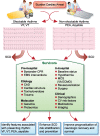Post-cardiac arrest evaluation: understanding non-shockable rhythms
- PMID: 31408103
- PMCID: PMC6911165
- DOI: 10.1093/eurheartj/ehz504
Post-cardiac arrest evaluation: understanding non-shockable rhythms
Figures


Comment on
-
Women have lower chances than men to be resuscitated and survive out-of-hospital cardiac arrest.Eur Heart J. 2019 Dec 14;40(47):3824-3834. doi: 10.1093/eurheartj/ehz297. Eur Heart J. 2019. PMID: 31112998 Free PMC article.
References
-
- Cobb LA, Fahrenbruch CE, Olsufka M, Copass MK.. Changing incidence of out-of-hospital ventricular fibrillation, 1980–2000. JAMA 2002;288:3008–3013. - PubMed
-
- Parish DC, Dinesh Chandra KM, Dane FC.. Success changes the problem: why ventricular fibrillation is declining, why pulseless electrical activity is emerging, and what to do about it. Resuscitation 2003;58:31–35. - PubMed
-
- Polentini MS, Pirrallo RG, McGill W.. The changing incidence of ventricular fibrillation in Milwaukee, Wisconsin (1992–2002). Prehosp Emerg Care 2006;10:52–60. - PubMed
-
- Herlitz J, Andersson E, Bang A, Engdahl J, Holmberg M, lindqvist J, Karlson BW, Waagstein L.. Experiences from treatment of out-of-hospital cardiac arrest during 17 years in Goteborg. Eur Heart J 2000;21:1251–1258. - PubMed
-
- Kuisma M, Repo J, Alaspaa A.. The incidence of out-of-hospital ventricular fibrillation in Helsinki, Finland, from 1994 to 1999. Lancet 2001;358:473–474. - PubMed
Publication types
MeSH terms
LinkOut - more resources
Full Text Sources
Medical

